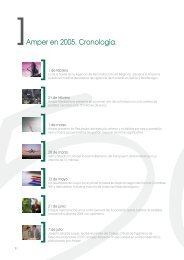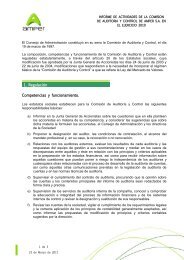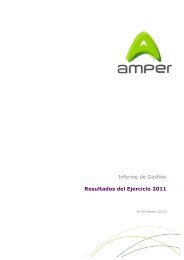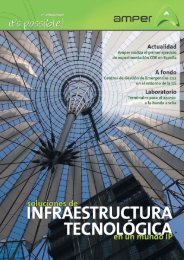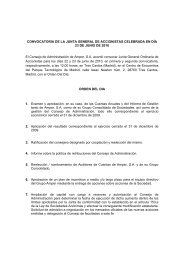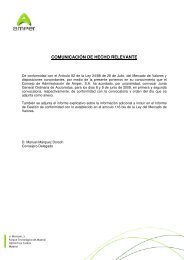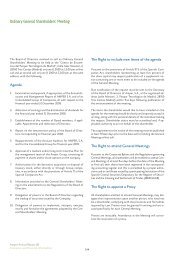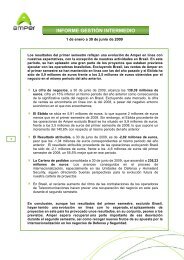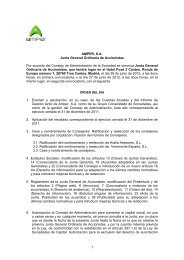AMPER, SA and Subsidiaries Consolidated Financial Statements for ...
AMPER, SA and Subsidiaries Consolidated Financial Statements for ...
AMPER, SA and Subsidiaries Consolidated Financial Statements for ...
You also want an ePaper? Increase the reach of your titles
YUMPU automatically turns print PDFs into web optimized ePapers that Google loves.
in<strong>for</strong>mation to be submitted by the Amper Group we will evaluate the existence of risks<br />
that need to be added to those already identified).<br />
- Types of risks: The risks to be highlighted in the risk identification process put in place<br />
by the Amper Group break down as follows:<br />
○<br />
○<br />
○<br />
Risks of a general nature: these affect the organizational structure <strong>and</strong> might<br />
potentially affect all of the processes related to the preparation of financial<br />
in<strong>for</strong>mation.<br />
Risks relating to the proper registering of the Group’s specific operations.<br />
Risks relating to the process of preparing regular <strong>and</strong> regulated financial<br />
in<strong>for</strong>mation.<br />
○<br />
Risks relating to the IT systems used by the Amper Group.<br />
As is evident from the different types of risks (quantitative <strong>and</strong> qualitative) covered by the “Policy<br />
<strong>for</strong> Identifying The Risk of Errors in the <strong>Financial</strong> In<strong>for</strong>mation of the Amper Group”, the Group<br />
considers the possibility of the risk of errors existing in certain processes that are not linked to<br />
specific types of transactions, but which are especially relevant bearing in mind their importance<br />
in preparing reported in<strong>for</strong>mation (such as the closing process, the process involved in operating<br />
in<strong>for</strong>mation systems, reviewing significant decisions <strong>and</strong> policies, among other processes).<br />
Among these is the consolidation process, which is why the Amper Group has established<br />
procedures aimed at ensuring both the correct configuration <strong>and</strong> execution of the process, <strong>and</strong><br />
the correct identification of the consolidation perimeter (said procedures are part of the<br />
corporate closing of accounts Procedure). It should also be noted that the process of identifying<br />
risks includes the possible effects of other types of risks (operative, technological, financial,<br />
legal, reputational, environmental, etc.) inasmuch as these could affect the financial statements.<br />
CONTROL ACTIVITIES<br />
Documentation describing the flow of activities <strong>and</strong> controls (including those relating to<br />
the risk of fraud) <strong>for</strong> the different types of transactions that could affect the financial<br />
statements in a material way, including the procedure of closing the accounts <strong>and</strong> the<br />
specific review of relevant decisions, estimates, valuations <strong>and</strong> projections.<br />
With regard to activities <strong>and</strong> controls relating directly to transactions that might have a material<br />
effect on the financial statements, the Amper Group has established controls to mitigate the risk<br />
of material errors (intentional or otherwise) in the in<strong>for</strong>mation reported to the markets. During<br />
fiscal year 2011 we revised, updated, <strong>for</strong>malised <strong>and</strong> documented our control activities in<br />
accordance with the recommendations of the Spanish Securities <strong>and</strong> Exchange Commission in<br />
its Guide <strong>for</strong> preparing descriptions of the internal control system <strong>for</strong> financial in<strong>for</strong>mation, this<br />
process being fully applicable to the account closing process.<br />
Said descriptions contain in<strong>for</strong>mation on what the control activity should consist of, what it is<br />
being executed <strong>for</strong>, who should execute it, how often, as well as any other in<strong>for</strong>mation on which<br />
in<strong>for</strong>mation systems or which activities carried out by third parties are relevant <strong>for</strong> the efficacy of<br />
the corresponding control activity.



